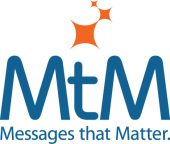Here’s a tip that makes it a lot easier to consistently deliver the same message in all your marketing communications from your web site to brochures to press releases. Create message strategies for anything important such as products, services and your company. Then use your message strategies religiously in all your marketing activities, repeating them over and over and over and over.
A message strategy consists of a positioning statement and three support points. Your positioning statement becomes the central idea and theme underlying all your marketing activities. A positioning statement is a short, compelling, declarative sentence that states just one benefit, and addresses your target market’s No. 1 problem. It must be unique, believable and important, or your target market will ignore your message. Here are examples of good positioning statements:
- “Tableau Software lets you see and understand your data.”
- “Kit Software helps you maximize the value of every commodity trade you make.”
- “SmartClient platform makes it simple to build powerful, high‑productivity web applications.”
- “Jive’s products and solutions help your employees, customers and partners work better together.”
- “SolarWinds system management software gives you instant visibility across all resources that can impact application performance.”
A good positioning statement easily adapts to various marketing communications – from web sites and trade shows to e-mail promotions, brochures and press releases. It should be simply stated and works in every aspect of your marketing effort. A positioning statement should be:
- Short – 12 words or less (not counting product name)
- Simple, non-jargon language
- Adaptable to various marketing communications
- A compelling statement of the one big benefit
- A conceptual statement…not necessarily copy
- Supported by three additional claims
Support points
Once you’ve developed a positioning statement, you need to bolster it with three to four supporting claims. Support points reinforce the importance, uniqueness and believability of the positioning statement. They provide the reason to believe the central positioning statement. Most importantly, support points must support, not compete with the positioning statement.
Use support points to unfold your story in more detail. They help explain your positioning statement, and answer questions like “how do you do deliver the promised benefit?”
Demonstrate your support
Supporting points also provide a structure for product demonstrations. While the positioning statement articulates a high-level benefit, the claims made in the supporting statements should be readily demonstrable. That is, in just a few steps, you should be able to show how the offering delivers concrete benefits.
Once you have developed supporting statements, you can drill down into as much detail as needed to provide a platform for product or company communications. A standard outline format makes it easy for writers and other communicators to see the message strategy’s benefit hierarchy, and to take full advantage of your work.
A solid message strategy makes it easier to deliver the same message across all marketing media including web sites, brochures, advertisements and presentations to investors, industry analysts and prospects. A message strategy is like a recipe for all marketing communication. Follow the recipe, stirring the ingredients and taste testing as you go, and…voilà, you’ve got a story that’s hard to resist.
